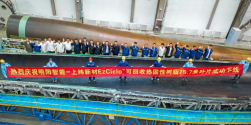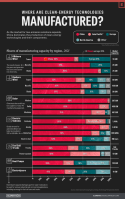You are using an out of date browser. It may not display this or other websites correctly.
You should upgrade or use an alternative browser.
You should upgrade or use an alternative browser.
Climate Change and Renewable Energy News and Discussion
- Thread starter FairAndUnbiased
- Start date
Brazil trip may be delayed, but it'd be good to set this up
There is news of this deal where Guofuhee and YDRO will setup a hydrogen project with a plant producing electrolysis equipment in Brazil. And to build hydrogen supply chain in Brazil.
There is news of this deal where Guofuhee and YDRO will setup a hydrogen project with a plant producing electrolysis equipment in Brazil. And to build hydrogen supply chain in Brazil.
Mingyang's 7.25MW floating turbines are getting installed in CNOOC's drilling platform to power them. Nice steps toward more deep water electricity generation.
MY got the most orders in 2022 with 17 GW of any Chinese wind turbine makers. Of which, 6.5GW is offshore. It has technology advantage over its competitors like Goldwind, Envision, CRRC & Sany
MY got the most orders in 2022 with 17 GW of any Chinese wind turbine makers. Of which, 6.5GW is offshore. It has technology advantage over its competitors like Goldwind, Envision, CRRC & Sany
Not a Chinese produced engine, but continued development of methanol engines will allow Chinese shipowners to transition to methanol engines and build infrastructure around that so that in the future, it will be welcomed into environmentally conscious nations that really care about this stuff.
As I said in the economic thread, green H2 and NH3 (and methanol) will be the major energy export of the future. They will need to continue to develop the hydrogen infrastructure.
Having hydrogen power plant like this that I talked about in sci & tech threads opens up many usage for hydrogen around the world
As I said in the economic thread, green H2 and NH3 (and methanol) will be the major energy export of the future. They will need to continue to develop the hydrogen infrastructure.
Having hydrogen power plant like this that I talked about in sci & tech threads opens up many usage for hydrogen around the world
A Chinese wind turbine maker just debuted
MingYang Smart Energy has launched a huge turbine blade made of over 95% recyclable materials – the first of its kind in Asia.
MingYang says it’s the “first Chinese OEM to offer recyclable blades.” Spanish-German maker and Danish company have also launched wind turbine blade recycling schemes.
The 75.7-meter-long (248-foot-long) prototype recyclable blade was made using Taiwan-headquartered wind power material supplier Swancor’s recyclable thermosetting resin. It has recyclable epoxy pultrusion plates with a recyclable foam core.
EzCiclo can be recycled and degraded with Swancor’s CleaVER recycling technology, and the recycled material can be used in other industries, according to a MingYang post on LinkedIn. Swancor :
The wind turbine blade composite parts made of “EzCiclo” can be recycled and degraded via “CleaVER” technology in the end-of-life. The waste is turned into recycled fibers and oligomers [it’s a molecule], and the recycled fibers can be reused to [make] glass fiber or carbon fiber composites.
Fangchenggang-3 is now connected and generating electricity. China really needs to step up its construction of nuclear plants. Overall, it's still way behind America in active nuclear plant, even though its tied for 2nd with France now.
Hard to say if Chinese CO2 emission rose or contracted in 2022.
Hard to say if Chinese CO2 emission rose or contracted in 2022.
Found a nice graph:


When looking at where clean energy technologies and their components are made, one thing is very clear: China dominates the industry.
The country, along with the rest of the Asia Pacific region, accounts for approximately 75% of global manufacturing capacity across seven clean energy technologies.
Based on the IEA’s 2023 report, the visualization above breaks down global manufacturing capacity by region for mass-manufactured clean energy technologies, including onshore and offshore wind, solar photovoltaic (PV) systems, electric vehicles (EVs), fuel cell trucks, heat pumps, and electrolyzers.
MingYang delivers the first Chinese wind turbines to be exported to Japan
Big moment. China was behind in wind turbine technology in the beginning, but it is now the leaders in offshore wind turbine technology thanks to MingYang
The deal was signed in end of 2021
with just 3MW turbines. They obviously have much better offshore turbines now.
Big moment. China was behind in wind turbine technology in the beginning, but it is now the leaders in offshore wind turbine technology thanks to MingYang
The deal was signed in end of 2021
with just 3MW turbines. They obviously have much better offshore turbines now.
Looks like Mingyang is the first Chinese wind turbine maker to use recyclable blades
There is a major wind power conference going on in Yangjiang right now. All the major heavy weights of Chinese wind power industry shows up
Mingyang won major offshore wind turbine contract. The cost of offshore turbine is almost double that of onshore turbines (onshore is around 2000 RMB/kw, offshore is 3700 RMB/kw in this case). It seems like for onshore, you max out around 8 MW and it's basically about who can lower the cost the most. Offshore it's more about who can build the largest and most technologically capable turbines and make a premium. So, MY is going for that sector. But all the turbines are over 10 MW, which is huge. This CZ8 project is 12 km from shore at depth of 12 to 26.5m, so it's not floating (still close enough to shore). The entire project is 500 MW. So pretty large contract.
There is a major wind power conference going on in Yangjiang right now. All the major heavy weights of Chinese wind power industry shows up
Mingyang won major offshore wind turbine contract. The cost of offshore turbine is almost double that of onshore turbines (onshore is around 2000 RMB/kw, offshore is 3700 RMB/kw in this case). It seems like for onshore, you max out around 8 MW and it's basically about who can lower the cost the most. Offshore it's more about who can build the largest and most technologically capable turbines and make a premium. So, MY is going for that sector. But all the turbines are over 10 MW, which is huge. This CZ8 project is 12 km from shore at depth of 12 to 26.5m, so it's not floating (still close enough to shore). The entire project is 500 MW. So pretty large contract.
people in West are now getting concerned that China will grow dominant in green H2. I've already talked about their advantage in electrolyzer, but what I did not realize was this part.
Here is the difference between China and the West. The west spends all day warning and make no plans. China just does things and build supply chain and expertise.
I think they get to close to 10 million ton a year by 2030.
They are making good progress on H2 ships. Looks like the new H2 ship also comes with a large battery pack. That should provide it enough range and speed with 500kW engine
increase access to H2 critical materials like iridium and nickel and support the development and completion of H2 projects.
...
it is critical to counter Chinese dominance over the supply chain of , such as .
...
Second, China plays a key role in the supply chain of minerals required for electrolyzers. (For example, .)
Here is the difference between China and the West. The west spends all day warning and make no plans. China just does things and build supply chain and expertise.
This is the good news, 20x sounds like a lot in 5 years, but it's just expanding so fast right now.China’s capacity to manufacture electrolyzers – the equipment used to make green hydrogen – could grow about 20 times by 2028 as costs of the clean energy source plunge, according to .
China’s electrolyzer market could be worth about 50 billion yuan by 2028, when domestic demand for the equipment will reach 40 gigawatts and green hydrogen production is likely to top 4 million tons, the analysts wrote
I think they get to close to 10 million ton a year by 2030.
This is actually a little high. IIRC, Sinopec already lowered it to $2.5/kg, which is way lower than Western countries (around $5 to 6/kg)Current production costs of green hydrogen are about 20 yuan ($2.90) a kilogram, compared to 10 yuan a kilogram using coal and 17 yuan a kilogram using natural gas.
They are making good progress on H2 ships. Looks like the new H2 ship also comes with a large battery pack. That should provide it enough range and speed with 500kW engine
